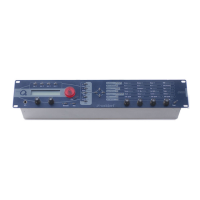Sound Parameters – Triggering of Voices
Waldorf microQ User´s Manual 50
Ctr Delay Modifier Delay
Modif. #1...#4 Modifier result #1...#4
minimum constant for minimum modulation (equals 0)
MAXIMUM constant for maximum modulation (equals +1)
Voice Num current voice number as mod source
Voice %16, %8, %4, %2 used voice number as mod source
Unisono V Number of unisono voices
U. Detune Detuning of all unisono voices
U. De-Pan De-panning of all unisono voices
U. De-Oct De-octaving of all unisono voices
Table 8: Standard Modulation Matrix sources
Triggering of Voices
As soon as a note is played, the microQ triggers one or several voices. How this triggering is done is
set by the following parameters. You can find these parameters in the Sound Edit menu located in the
Master section.
Sound Edit Menu
Mode | Unisono
Poly | Dual
Mode Poly / Mono
Controls if the Sound can be played polyphonically or monophonically.
• Poly means that each note triggers its own voice or voices, as on a piano.
• Mono means that only the last played note sounds. All other notes are stored in an internal
list but aren’t played. As soon as you release the note that is currently played, the second
last note is played and so on. When you play legato, only the first note that was played
triggers the envelopes. All later notes use these envelopes, but sound in the pitch you’ve
played. This mode is for sustained sounds like typical 70’s solo sounds.
When Mono is selected and you have set up a decaying volume envelope for the selected
Sound, you might not hear anything after playing several notes because of the envelopes
decaying to 0.
Unisono Off / Dual / 3…6
Controls how many voices are triggered when a note is played.
• Off means that a note triggers one voice. This is the standard mode.
• Dual means that a note triggers two voices. Both voices have high priority so they can cut
off other voices that are played.
• 3…6 means that this number of voices is triggered when a note is played. Only the first
voice has high priority, meaning that it can cut off other played notes. The other voices can
only sound if any voices are free or if there are other unison voices with lower priority that
could be cut off. This ensures that older notes play at least one voice as long as the voice
allocation isn’t forced to steal even this voice for a new note.

